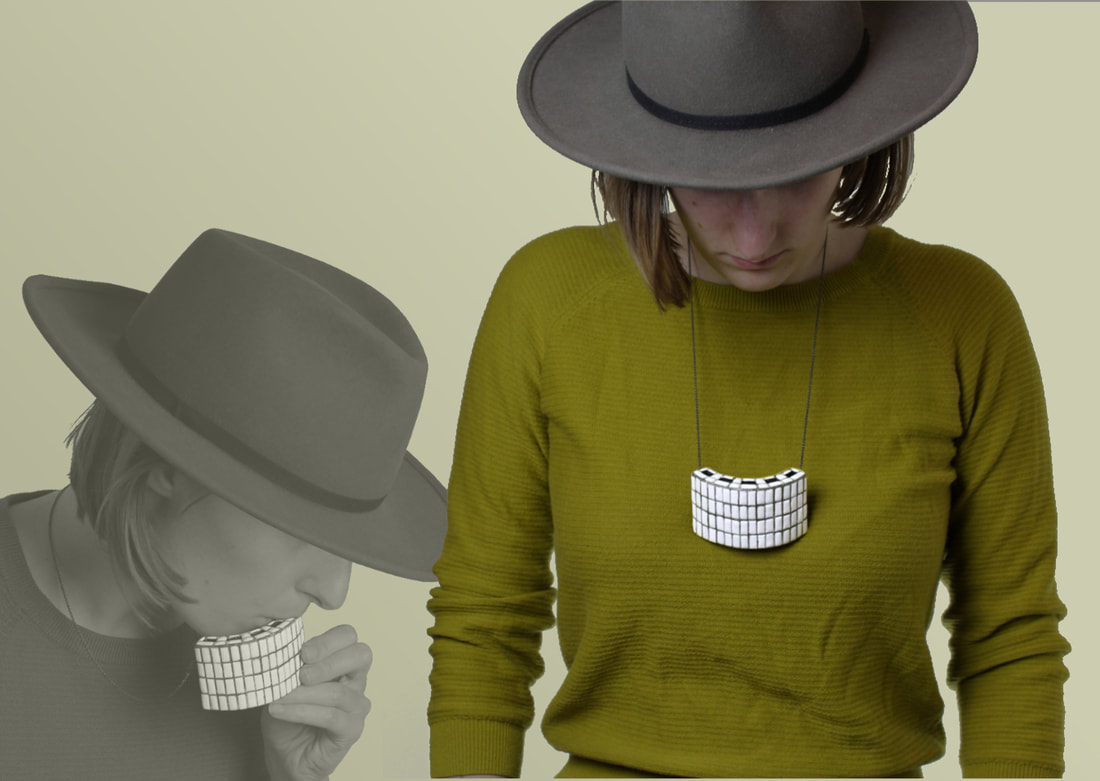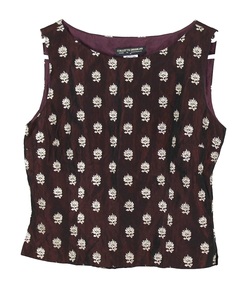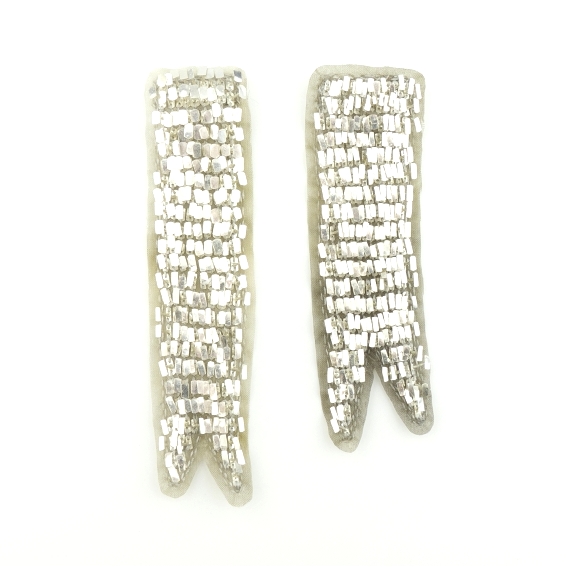|
PLY
2019 Rubicon ARI, Melbourne Ply: to work steadily with a tool to practice regularly to repeatedly supply Plier: a hand tool used to hold objects firmly a person or thing that plies From the Latin plicāre: bend/fold. PLY explores the bending of metal with pliers. An action performed by jewellers and metalsmiths innumerable times in their career, but an act which is often unobserved, shrouded in the mysteries of the solitary workshop. This performative work exaggerates the action and brings the process of making into public view. |
|
|
|
Materials
Pliers: steel pipe and bolt from a scrap yard Boilersuit: linen, red painted aluminium buttons made from second hand pots and pans Stamping die: second hand steel Neckpieces: aluminium from second hand pots and pans, recycled sterling silver tube, cord |
Made/Worn: Australian Contemporary Jewellery at Australian Design Centre and touring nationally 2020-2022.
Regent Honeyeater, 2020, recycled red ironbark (Eucalyptus sideroxylon), steel from an old car exhaust, leather Leadbeater's Possum, 2020, recycled mountain ash (Eucalyptus regnans), steel from an old car exhaust, leather South-eastern Red-tailed Black Cockatoo, 2018, river red gum (Eucalyptus camaldulensis), steel from an old car exhaust, leather Bornemisszas Stage Beetle, 2020, blackheart sassafras (Atherosperma moschatum), steel from an old car exhaust, leather Swift Parrot, 2020, recycled messmate stringybark (Eucalyptus obliqua), steel from an old car exhaust, leather Up North
2017 Gray Street Workshop Gallery, Adelaide The Lost Ones, Ballarat Gallerysmith project Space, Melbourne |
|
|
Up north it's cold. This summer doesn't fit with her experiences of summer. The plants grow in a desperate frenzy and are hacked into submission by the local school children. She has to quickly gather the plants for dyeing before they disappear.
She sees how the people influence the landscape. And how the landscape influences the people. Why do you always see sheep in threes? How do you souvenir a mountain? What is a blueberry? This exhibition of work by Claire McArdle explores her experiences of Iceland told through objects and jewellery. |
Icelandic Wool Natural Dye List
|
1&2 Yarrow
3 Yarrow exhaust bath 4 Downy Birch leaves 5A Crowberries 5B Crowberries exhaust bath 6A Crowberry Plant 6B Crowberry Plant exhaust bath 7 Downy Birch Bark 8 Rhubarb Roots 9 Field Horsetail |
10 Purple Flower
11 Rowan Leaves 12 Common Sorrel Roots 13 Dandelion Roots 14 Dandelion Flowers 15 Dulse 16 Dwarf Birch Twigs 17 Downy Birch Twigs 18 Lupin Seed Pods 19 Lupin Leaves |
20 Bog Bilberries
21 Rhubarb Roots exhaust bath 22 Bog Bilberries exhaust bath 23 Lady's Bedstraw roots (no colour) 24 Crowberries 25 Crowberry Plant 26 Soft Pine Tree 27 Sunburst Lichen 28 Dwarf Birch Leaves 29 Common Sorrel Flowers |
|
Sextet
2017 vitreous enamel, copper, sterling silver, wood, brass Das KloHäuschen, Munich, Germany I had never visited Das KloHäuschen in person before our collaboration but I grew to know it over the many months of our association. It was once a urinal but has been an art space for the past 9 years. This collaboration existed through representations on the internet. I scrutinised images for details that would be so obvious in person. With this virtual knowledge I constructed instruments echoing the physical structure of the space. The instruments create sound and can be worn on the body. When the work was presented in Munich it was curious to be in a space which I have examined for so long from such a distance. Six pieces for the six urinals make up the Sextet. For a while the instruments adorned the space of their inspiration and you could hear the song that was made through this collaboration. The song for Das KloHäuschen. |
|
|
Quintet
2017 A-galerii, Tallinn, Estonia Quintet is a series of five jewellery pieces which can be both passively worn and actively played as instruments. Their forms illustrate differences between Australia and Estonia as experienced by the maker, the stars, the long twilight, the landscape, collecting wild blueberries on a strand of grass and pickles. The body of the form is made from a crushed Vana Tallinn bottle (Estonian liqueur), the most accessible physical Estonian product in Australia. Together their sounds make up the song which is played at their exhibition in The Vault. The song for Tallinn. |
|
In Australia, the beach has played a large role in the shaping of a national identity. There has been a constant companion on to the long summer days. An invisible barrier to a beloved enemy. It creates a physical shield to protect our soft skin from the rays blazing through our ozone poor atmosphere. Keys, wallet, phone, sunscreen.
|
|
Gilty
An exhibition experienced twice. 2013 |
|
The First Experience
|
If an illusion deceives your perception does it make the first understanding invalid
Does a gilt object betray us in some way or does it possess a truth of its own? A skin of gold matches the contours of the bead in precise detail. It masks the underlying material of the piece which makes up 99% of its volume and 0% of its surface. How do you value the piece? Is this piece pretending to be something else or is it exactly what it is and we have deceived ourselves with visual assumptions? If you know that the chain carrying the beads, the chain which is almost fully covered, is made of 18ct gold, how do you value the piece now? Is this a truth wrapped in a deception? Or is it just a piece to be perceived with available knowledge and accepted for its form and known materiality? Is this work guilty for being gilty? |
Hyt is not al golde that glareth
We live in a society that litters our screens with images of self, strangers, food porn and cute kittens. We are often quick to judge by appearance, not always willing to entertain the real riddle of our reality. Aren’t we always told not to judge a book by its cover? Is it not also true that one rarely triumphs when choosing a wine by the design of its label alone? Geoffrey Chaucer, the ‘father’ of English literature, was known to chide Hyt is not al golde that glareth. It seems Chaucer was giving us fair warning: not everything is always as it appears. Claire McArdle, through her jewellery, explores this notion of appearance and by extension the idea of value. In Public Displays of Attentionfrom 2011/12, McArdle created loud, colourful, costume-like adornments and invited the viewer to choose which piece or pieces they felt best expressed themselves. Further to this the viewer was invited to pose and have their image captured in a portrait later sent to them by McArdle as a memento of that fleeting moment and feeling. This installation of work spoke clearly; it declared its intentions loudly and brightly, with much wit and enthusiasm. McArdle’s latest body of work, Gilty, seems to speak in whispers and riddles. This work asks you to lean in close, to draw breath and make some serious decisions as to what you are seeing, what you believe you are seeing and what it is worth. With this work the words of Chaucer, (and the more famously misquoted Shakespeare “All that glisters is not gold”) come to mind. Within Gilty, McArdle challenges the paradigm of jewellery. The works seem to collide the notion of value in costume jewellery with its visual ‘fake realness’ and the traditional values of ‘real’ preciousness. Do you eventually throw your hands in the air with reckless abandonment and mindlessly enjoy and desire these pieces? Or do you continue to walk though the labyrinth relishing the contradictions and attempting to solve the riddle McArdle has served you up? Zoe Brand Jeweller/Curator |
|
|
The exhibition was opened by Mark Edgoose.
At the end of his speech he walked to the piece behind him. Snapped off an arm, popped it in his mouth and walked away. Much to the shock of the watchers. |
The Second Experience
|
Neckpieces experienced once as wearable gilt forms. Experienced again as edible gilt beads revealing the true gold chain beneath. The pieces have not changed, they are as they always were. But the circumstances of perception have shifted.
If an illusion deceives your perception does it make the first understanding invalid? Does the object betray us in some way or does it possess a truth of its own? Objects once untouchable, displayed on gallery walls are now free to be consumed. Something on the body to become something of the body. The chocolate interior of the bead, once masked, is used by our bodies as the piece performs a new energetic role. While the gilt exterior, once admired for its value giving properties, passes through to not affect. What is their value now? The perception of these pieces changes but their materiality does not. Were they a truth wrapped in a deception? Or were they to be perceived and perceived again with the available knowledge and accepted for their form and materiality? Gone is the grand display of the beads, leaving behind the chain. Stripped of its original purpose, it must take on a new role. Is it a memory keeper for its previous form? Or is it free to be perceived as it is now? No longer gilty, just gold. |
To consume or consume?
We live in a society that plasters our screens with images of excess wealth, epic fails, coffee art and cute kittens. We are often quick to judge by appearance, not always willing to entertain the real riddle of our reality. Aren’t we often warned that still waters run deep, that you only see the tip of an iceberg? Geoffrey Chaucer, the ‘father’ of English literature, was known to chide Hyt is not al golde that glareth. It seems Chaucer was giving us fair warning: not everything is always as it appears. Claire McArdle, through her jewellery, explores this notion of appearance and by extension the idea of value and experience. In Public Displays of Attention from 2011/12, she reveled in the performative. Forcing a reaction from her viewers, by asking them to adorn themselves with fabulous, bright, costume- like trimmings. McArdle engages the audience in an experience by inviting them to touch and to boldly take these pieces off the stark white walls of the gallery and apply them to their bodies. How does one look in such a piece? McArdle’s latest body of work, Gilty, seems to murmur with cunning; not everything is always as it appears. This work asks you to lean in close, extend your hands and literally tuck into it. To consume or consume? This new work makes you question what you thought you were viewing, how does it make you feel about it now? Within Gilty, McArdle challenges the paradigm of jewellery, real verses fake, the traditional gallery ‘DO NOT TOUCH’ canon and asks you to question the whole experience. Do you eventually throw your hands into the air, and mindlessly enjoy and delight in the edible encounter? Or do you continue to walk though the labyrinth relishing the contradictions and attempting to solve the riddle McArdle has, quite literally served up to you? Zoe Brand Jeweller/Curator |
|
|
Worn Translations
2013 The clothing has a story. The owner shares the story. The owner trades the clothing. The clothing is un-made. The material now formless. The material re-formed. Worn and worn. The material is translated. Translated, trans-formed. The story is retold. |
Public Displays of Attention |
This attention grabbing jewellery creates a visual voice which cries out joyously to the many strangers we encounter everyday during city life. Colossal and colourful, these pieces all carry an urge to be connected to others. They create a shared experience for both the wearer and the viewer as they become part of one of the many ‘Public Displays of Attention’.
At the opening people could try on their preferred piece and see if it attracted the right amount of attention for them. As well as having a photo with their favourite as a souvenir postcard. Materials: hand dyed silk, sterling silver, mixed media. Second solo exhibition. |
Public Displays of Attention
2012, Studio 20/17, Sydney
Public Displays of Attention
2011, First Site Gallery, Melbourne
|
|
Tokens of Place
This is a series of jewellery I have crafted from collected fragments of the environments I have encountered. These fragments are usually loose rocks, which I crush and set into jewellery as a reminder of the place they were found. The pieces connect people with places. Each piece is named after the place and time of its rocks collections, for example “Exhibition Street, 2pm”. Each piece holds a memory of a place, to be carried with the wearer on their personal journey. All the pieces are blackened silver with the variation in colour and texture of the rocks presenting a palette of the urban and rural environments of their collection. The pieces could be from a street you walk down every day. These collected works are a history of place for me. A journey traced in jewellery. They are a memento of a moment. A token of a place. (First solo exhibition in 2010) |
|
Claire McArdle, Sock Status: artefacts from a recent history cult, 2011, mixed media.
This piece was my final work from my semester at the Eesti Kunstiakadeemia (Estonian Academy of Arts) in Tallinn, Estonia.
Sock Status: artefacts from a recent history cult could be walked through to experience and examine the many elements which comprised it. The piece was a fictional display of an exhibition from the discovered remains of a practicing cult. Don't forget to visit the gift shop on your way out. |
|
|
Winner of Contemporary Wearables '13 and acquired by Toowoomba Regional Art Gallery.
|
The Emu
2013, gold leather & polystyrene Dear Diary,
Why is it that when people think of a national symbol for Australia they always pick the kangaroo? I'm just as good as the kangaroo, better even. Just because the kangaroo got to stand on the left on the coat of arms. But I'll show them all. Wait until they see my new look. Gold is so hot right now. I just hope no one thinks it's real gold and cuts my head off. Emu xox |
|
The (kanga)Roo
2012, fluoro pink kangaroo leather & polystyrene 50x21x23mm The kangaroo, the symbol of Australia. But what does it mean to be Australian? What happens when you dissect away the familiar body and are left only with the infinitely more ambiguous head?
This piece asks questions of national identity both at home and within a global society. It sits boldly on the chest, confronting, questioning, protruding through personal space. Its blank eyes offer no direction forward but merely reflect the infinite scope of decisions not yet made, of questions left unanswered. Our uncertainty of identity is accentuated in this new symbol which utilises that most controversial of colours. Used as a weapon of prejudice and of freedom. The last colour to have any vestige of taboo. The new symbol is made from the old. The furry brown heritage transformed into the fluoro pink leather as the questions mount. Who are we? What is we? We are Australian? |
Touring to the UK, Germany, Austria & USA as part of Suspend.ed in Pink.
|
|
|
This is Jewellery
2012, sterling silver, silk The two dimensional artwork is traditionally hung on the wall. It is experienced with the eyes but not with the body. This piece is a re-presentation of a symbolic form as jewellery. It takes the most recognised form and conventional placement of art but retains the notions and functionality of jewellery. The use of metal connects to jewellery while the use of silk relates to the canvas.
Is jewellery art? What is art? This is jewellery. This piece was exhibited in Hong Kong & Sydney with mmmmm...exhibition. |
|
Rosette (ribbon series)
2012, sterling silver, silk, stainless steel 170x100x10mm The rosette is fabric pinned to the body in that place usually reserved for jewellery. It distinguishes the wearer and bestows honour and recognition through its identifiable form. This piece is about the form as a symbol based on the concept rather than the consequence of an achievement. It is the re-presentation of the symbol as adornment.
Worn on the chest with its static fixation it takes reverential pride of place. Status is garnered not only from its form but from its location. This piece is a symbol made into jewellery based on status adornment. The use of metal connects to jewellery while the use of silk relates to the rosette. Both take on qualities of the other as the silver components remain flexible and the silk substrate is proceeded by a cool, hard canopy of silver. This piece was part of Its Got Legs in Melbourne.
|
|
|
Works from 2010 |
|
|
|
Works from 2009 |
I would like to acknowledge the people of the Kulin Nation as the Traditional Custodians of the unceded land on which I was born, live and on which my work is made. And to recognise their continuing creativity and connection to making. I pay my respects to their Elders past and present and to all Aboriginal and Torres Strait Islander people of this country. And all First Nations people around the world.






















